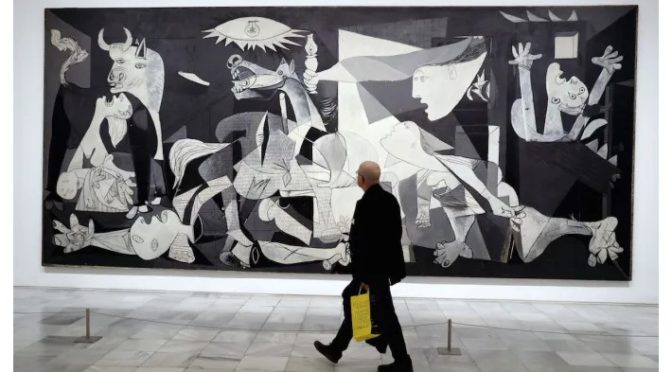“Art is a lie that makes us realize the truth” –Pablo Picasso
Pablo Picasso (Spanish, 1881-1973) was one of the most well-known artists of the 20th century. Throughout his long and prolific career, Picasso both innovated and participated in important artistic movements such as realism, cubism and surrealism. In comparison to Vincent van Gogh, the infamous starving artist, Picasso was one of the first modern artists to achieve great wealth and celebrity in his lifetime.
Possibly the most important work that Picasso produced was Guernica (1937).
This large scale black and white mural (approximately 12 x 26 feet), was commissioned for the Spanish Pavilion in the 1937 World’s Fair in Paris and was completed by Picasso in under a month. In it, the artist depicted a catastrophic incident from the Spanish Civil War, wherein the Nazis conducted carpet bombing experiments on the town of Guernica, in the Basque region of Spain.

Historically, Spain had been ruled by a monarchy up until the 1930s, at which time it was replaced by a republican government that promised social and economic reform and a redistribution of goods and land. Spanish conservatives disliked this idea and headed by General Francisco Franco, they launched an insurrection that led to the Spanish Civil War. Aided by the Fascists and Nazis, General Franco assumed dictatorship of the country and ruled until his death in 1975.
During this time of turmoil, Picasso was not in Spain but working in Paris.
This is important to note when considering his choice of palette. He would have been paying attention to the events taking place in his native country largely through newspapers, transforming the black and white newsreel into a large scale canvas. Also, by choosing a dichromatic colour scheme, Picasso allowed the subject matter to stand out over colour.
Prominently positioned in this work is the Minotaur (a half-bull/half-man monster), an important symbol for Spanish people representing the tyranny of General Franco and his Nazi and Fascist supporters. Picasso used distortion in the imagery and figures to portray the horrors and suffering of innocent civilians massacred by the carpet bombing. This, in combination with the palette, evokes in the viewer the sensation of a stark nightmare, tying the work to the surrealist movement.
On a final note, Picasso was adamant that this work not be displayed in Spain until democracy was restored.
On loan to the Museum of Modern Art in New York, Guernica was returned to Spain in 1981. For the Silo, Eve Yantha.


Leave a Reply
You must be logged in to post a comment.